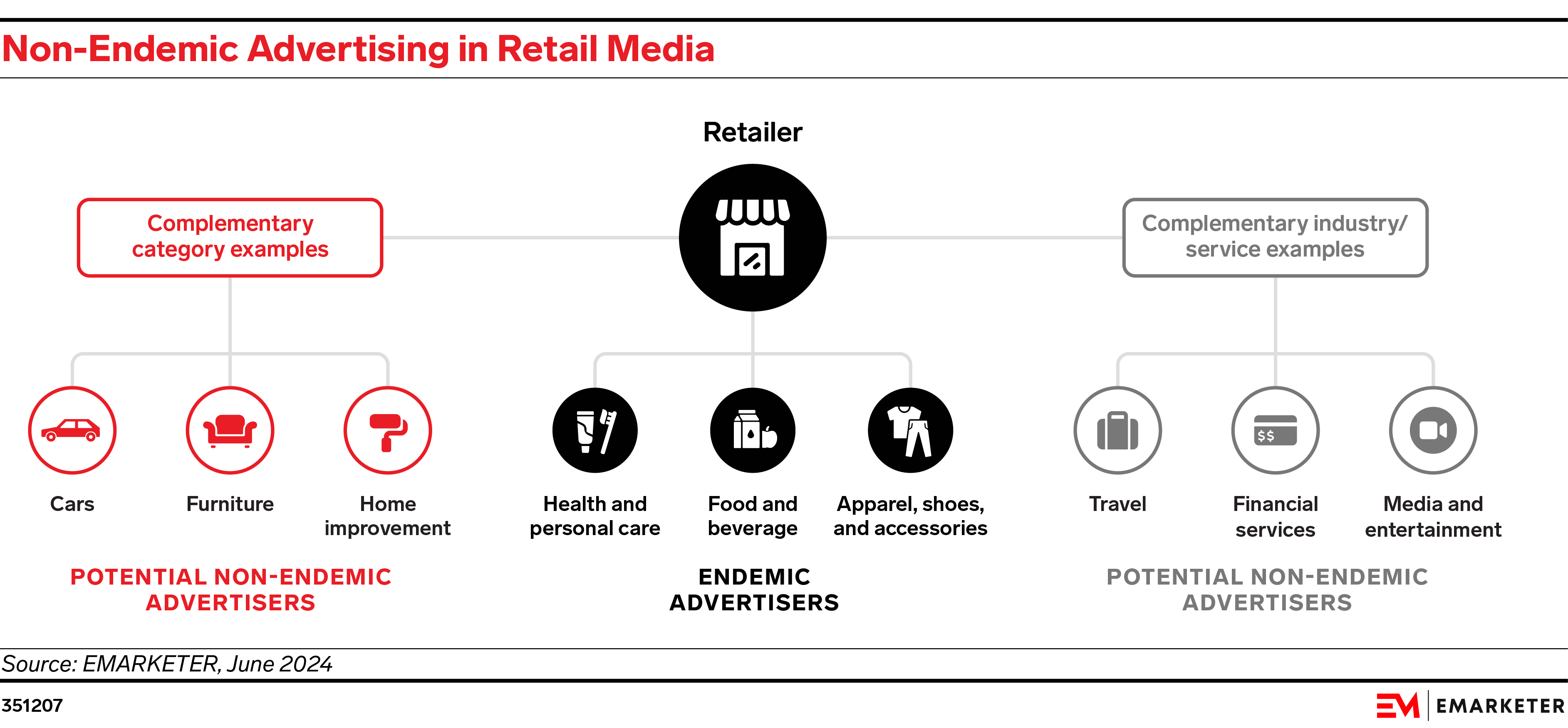Not A CPG Brand? Retail Media Can Still Be Your Secret Weapon

Retail media networks have become a dominant force in digital advertising, giving brands direct access to highly engaged shoppers at the moment of purchase. Historically, RMNs’ growth has been fueled in large part by endemic advertisers – brands that sell products through a retailer itself. But a new wave is emerging: non-endemic advertisers, or advertisers whose products aren’t for sale at that retailer. And with the rise of offsite retail media network inventory, this is poised to underpin RMNs’ next stage of growth.
For retailers, agencies, and brands that get this right, the opportunity is massive. Non-endemic ads – think travel companies advertising on a department store’s site or credit card offers in a grocery app – show that retail media isn’t just about selling a product. Done well, they enhance the customer experience while unlocking new revenue streams for retailers.
Yet, despite the potential, non-endemic advertising remains an underutilized strategy. Why? Because it’s a balancing act. When done thoughtfully, non-endemic advertising becomes a strategic complement to the shopping experience. But if executed poorly, it can feel intrusive, irrelevant, or even damage customer trust.
From annoying to additive: How non-endemic ads can enhance the experience
One of the biggest hesitations around non-endemic advertising, both for advertisers and retailers, is the fear that it might disrupt the shopper journey. An advertiser may be concerned that its message is out of place, for example, or a retailer may worry that it could get in the way of the path to purchase. However, when placed strategically, these ads can add considerable value.
For example, a high-end grocery retailer could run non-endemic ads for a premium cookware brand, a meal subscription service, or a high-rewards credit card – all of which align with the shopping behavior of their customers. Rather than feeling intrusive, these ads become helpful recommendations that complement their interests.
The challenge is relevance. If a customer shopping for organic groceries suddenly sees ads for fast-food delivery, it wouldn’t align with their interests and may risk diminishing trust in both the retailer and the advertiser. Retailers must ensure that non-endemic ads are contextually aligned, adding value rather than feeling like a cash grab.
Non-endemic, non-competitive: A smarter way to grow ad revenue
Retailers initially relied on endemic brands to grow their RMNs, but that growth has its limits. Brands selling within a retailer’s ecosystem may not always have the ad budgets or scale to drive substantial revenue. Non-endemic advertisers, on the other hand, offer an entirely new stream of demand without competing for the same dollars from endemic brands.
For instance, an auto insurance company advertising on an automotive retailer’s site doesn’t take away from tire or car battery sales – it simply provides an additional layer of relevance and utility to shoppers.
But retailers must be careful not to over-monetize their platforms at the expense of user experience. Too many ads – or poorly placed ones – can erode trust and make shoppers feel like they’re being sold to rather than served.
Retailers have something non-endemic advertisers desperately need: first-party data
With third-party cookies disappearing, advertisers are searching for better ways to target relevant audiences with precision. Retailers own some of the richest first-party data in the industry, making their RMNs highly attractive even to brands that don’t sell their products there.
Non endemics who are looking to future proof their advertising investments with this continuously impending deprecation with a third party cookie are also seeing the value of retailers first party data. So you have this nice ideally tidy case of two-way demand, where the retailers are looking to further monetize their data, use their toolkit to expand beyond the walls of their endemic brands, and you’ve got these non endemics who have an appetite to really be able to leverage that data.
But simple behavioral targeting doesn’t cut it here. A travel brand advertising with a grocery retailer, like Kroger or Albertsons, may know that a customer recently purchased snacks and sunscreen – but does that really indicate a readiness to book a flight?
Companies like Infillion help non-endemic advertisers navigate this challenge by offering sophisticated programmatic targeting solutions that leverage retailer data more effectively. The key is not just access to data, but the ability to interpret it correctly – ensuring that ads are reaching the right consumers at the right time.
The expansion of commerce media networks unlocks even more potential
Commerce media takes the retail media model and extends it to finance, travel, and other industries where transactional intent is high. Banks, airlines, and hotel chains are now monetizing their first-party data to allow advertisers to reach consumers at pivotal decision-making moments. It’s almost like the opposite where the retailer/brand selling the product becomes the “non-endemic” for the commerce media network.
Either way you look at it, this evolution means more access to high-value audiences outside of retail environments. Rather than just targeting where consumers shop, brands can now engage them where they travel, bank, and book experiences.
This can make a media network-centric strategy more appealing for non-endemic brands. Instead of relying solely on retail media, they can diversify into commerce media networks that offer additional audience alignment, rich intent signals, and more creative ways to engage consumers.
Beyond the buy button: Proving the value of non-endemic advertising
Another roadblock in scaling non-endemic advertising is measurement. Endemic brands have a clear and direct path to attribution – if someone clicks an ad for a shampoo brand and buys it on the retailer’s site, the impact is obvious.
For non-endemic advertisers, attribution is more complicated. If a credit card company advertises within an RMN, how does the retailer prove that exposure led to a sign-up? Without clear metrics that demonstrate the impact of non-endemic advertising, retailers may struggle to convince advertisers to invest at scale.
Retailers must work with trusted ad tech partners to refine attribution models – leveraging multi-touch attribution, incremental lift studies, and cross-channel measurement tools to prove the value of non-endemic advertising.
Make it seamless not spammy: Align with shopper intent
For non-endemic ads to drive real impact, context matters. A luxury travel brand advertising in a high-end fashion retailer’s app makes sense – but serving that same ad to a bargain-focused grocery shopper mid-checkout? That’s a miss.
Retailers must ensure that non-endemic ads are seamlessly integrated into the shopping experience, not as intrusive detours. By leveraging real-time intent signals, contextual relevance, and dynamic creative optimization, they can place these ads in moments where they naturally enhance – not disrupt – the customer journey.
Ad tech partners like Infillion help retailers and advertisers refine their targeting strategies to ensure that non-endemic ads feel timely, valuable, and personalized – rather than just another impression.
Placing non-endemic ads where they belong
Retail and commerce media networks are still in their early days, and the opportunities for non-endemic advertisers are even newer. The brands, agencies, and retailers that approach this strategically – balancing revenue generation with customer experience, refining audience targeting, and innovating beyond traditional ad placements – will be the ones that capture the biggest opportunities.
For those who ignore it? They’re leaving money on the table.
Connect with us today to discover how Infillion can help you expand your retail media business and manage it more effectively.
Subscribe to our blog:
Related Posts:

From Data to Decisions: Preparing Retail Media for AI Agents
Why infrastructure maturity is the key to future growth Artificial intelligence is already reshaping digital advertising. Predictive algorithms now steer bidding strategies, and machine learning models help refine audience targeting. But in retail media, the...

Retail Media’s Budget Tug-of-War: Uniting Brand and Demand Through Full-Funnel Strategies
Retail media has grown up fast. What started as a straightforward way to capture search dollars at the point of purchase is now one of the most scrutinized and strategic channels in the industry. Retail media is no longer just about conversion rates and ROAS—it’s...

From Hype to Reality: Agency Perspectives on Retail Media Networks
Every week seems to bring a new retail media launch or partnership announcement. Investment is rising, innovation is happening, and retailers across verticals are racing to build and/or improve their media networks. But when we surveyed agency leaders for our latest...
Let's Connect


